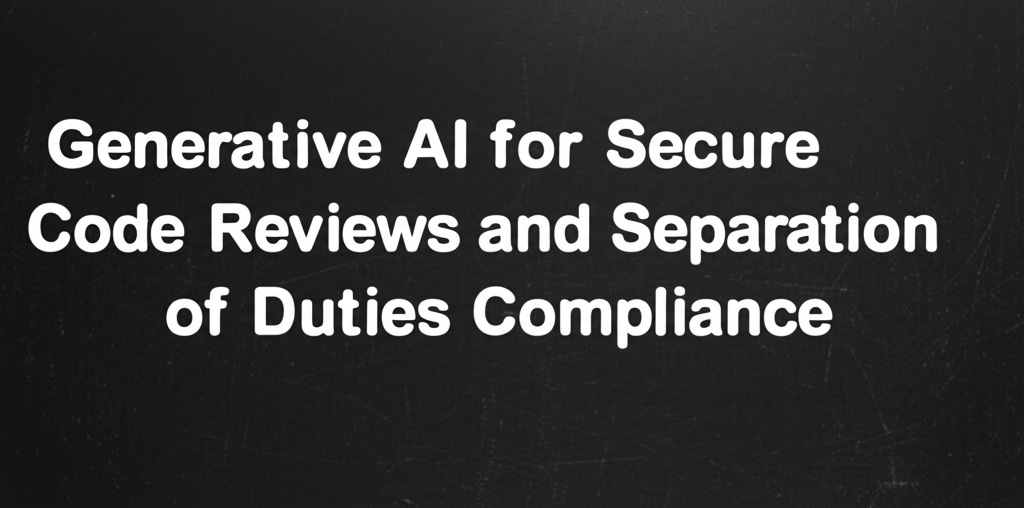ML Case-study Interview Question: Generative AI for Secure Code Reviews and Separation of Duties Compliance
Browse all the ML Case-Studies here.
Case-Study question
A large enterprise seeks to integrate a generative AI-powered assistant into their code review workflows to improve compliance with separation of duties. They want to automate manual review tasks, maintain strict compliance with industry standards, and reduce security risks. As a Senior Data Scientist, how would you design, implement, and validate such a system? Outline your approach in detail, focusing on how the system could suggest descriptive pull request summaries, highlight security vulnerabilities, and enable an efficient code review process that meets separation of duties requirements.
Proposed Solution
Compliance programs often require a clear review process. An AI-driven code review assistant can streamline these workflows, generate objective summaries, and identify hidden vulnerabilities without relying on a single human reviewer. Below is a detailed breakdown of how this could be set up:
Generative AI integration
Use a generative language model trained on code. Host it in a secure environment to avoid exposing confidential data. Provide access only via authenticated requests. Keep track of every interaction for audit trails.
Pull request summaries
When a pull request is submitted, feed the code differences into the AI model. Generate descriptive text that explains code changes. Store these summaries in the repository. Enforce a rule that requires the reviewer to read and confirm the summaries before merging.
Automated vulnerability detection
Train the AI model on patterns of common code smells, security flaws, and compliance issues. Have it annotate areas that might introduce risks. Log these annotations so that security and compliance teams can trace decisions.
Separation of duties enforcement
Ensure the AI system has privileges only for reading code and suggesting improvements. Restrict merge privileges to separate user accounts or roles. Require final approval from a human. Keep these accounts distinct per compliance guidelines. Block merges if the same account authored and reviewed the code.
Evaluation and metrics
Track how often the AI-driven recommendations align with human reviewers. Collect statistics on reduced time spent in manual reviews. Measure improvement in the overall coverage of code scanning. Assess how quickly vulnerabilities are found and fixed. These data points confirm return on investment.
Future scalability
Use a modular architecture so new features can be added, such as policy checks or advanced risk scoring. Expand the AI to review infrastructure configurations or policy scripts. Maintain regular model retraining with newly approved code bases, ensuring the AI remains updated with organizational coding standards.
What would be the main privacy and security considerations when integrating a generative AI code review feature?
Models must run in a contained environment so code remains confidential. Restrict training data to internal repositories or publicly approved data. Avoid sending any proprietary code to external services. Provide rigorous logging of every model query and keep strict access controls. Limit AI outputs to relevant suggestions only, and enforce data retention policies for generated content.
How would you handle potential model inaccuracies or hallucinations in code reviews?
Maintain human oversight. Use the model to provide additional insight, not as a sole decision-maker. Implement a requirement that any AI-generated suggestion be validated by an authorized reviewer. Flag questionable model outputs, and gather feedback to refine future model updates. Keep an iterative training loop, focusing on examples where the model erred.
Why is separation of duties important in this context?
It helps prevent a single person or automated agent from pushing unchecked code directly to production. A separate reviewer role (or AI plus human) keeps a second set of eyes on changes. This enforces compliance by ensuring that no single account or function can make unilateral decisions on code merges. It reduces the risk of malicious or inadvertent harmful changes.
How would you integrate the AI system into the existing continuous integration pipeline?
Add a step that triggers the AI-based review once developers submit a pull request. Require the system to generate summaries and potential risk flags. Capture these outputs in a database or log. Surface them in the pull request interface for human review. Make the pipeline block merges until an authorized reviewer has confirmed everything. This approach ensures consistent enforcement at every code update.
How can you demonstrate to auditors that your AI-based process meets compliance standards?
Provide logs of model outputs, summaries, and approval timestamps. Show that code merges only happen if a separate authorized account confirms them. Document the AI’s role, specifying it has no direct merge rights. Maintain versioned, read-only records of each pull request. These records illustrate that the AI assistant acted as a reviewer, not as the final approver, thus meeting compliance guidelines for separation of duties.
Could this system be extended to cover other aspects of compliance, such as Infrastructure as Code or Policy-as-Code?
Use the same approach. Feed the configuration or policy scripts into the AI for analysis. Generate compliance summaries with references to relevant standards. Highlight suspicious resource changes in IaC files. Keep the same separation of duties principle. Prevent direct auto-deployment without a second approval, ensuring compliance across every layer.
How would you handle continuous improvements and feature requests for the AI system?
Adopt a feature development cycle with incremental releases. Gather user feedback on false positives, missed vulnerabilities, or suboptimal summaries. Refine training data by incorporating new code examples and real-world feedback. Conduct periodic model evaluations against known test suites. Maintain a collaborative environment with compliance, audit, security, and developer teams.
How would you mitigate the risk of the AI model leaking proprietary data in its generated summaries?
Enforce strict sanitization rules on the output text. Implement guardrails that mask sensitive identifiers. Keep an internal dictionary of sensitive terms, blocking the AI from returning them verbatim. Insert a check in the pipeline to detect any accidental leaks. Log all suspicious outputs. Revoke or quarantine them for manual review if the system identifies potential data exposure.


